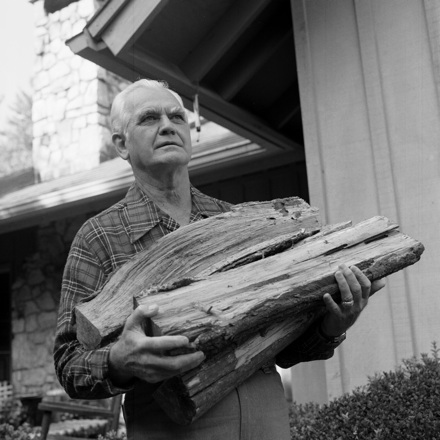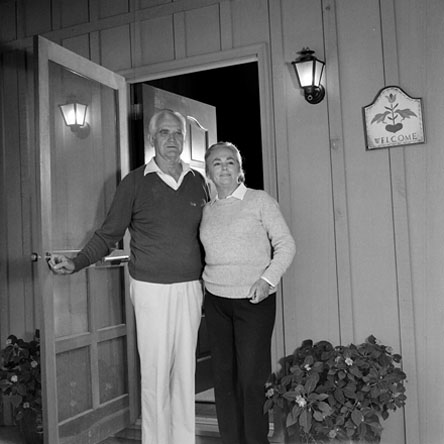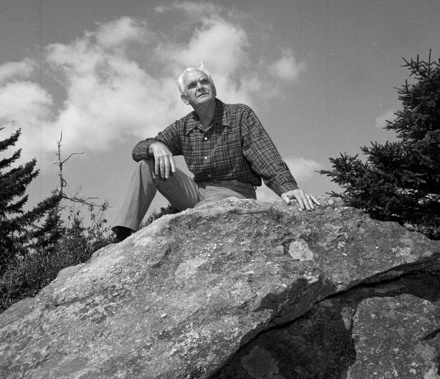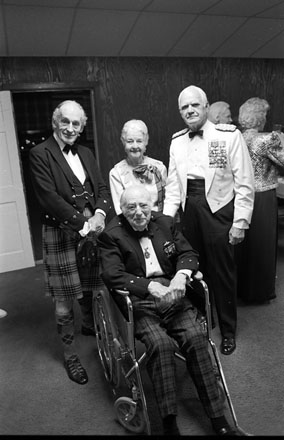
Hugh Morton cultivated many relationships in his various roles as photographer, publicist, land developer, and civic pillar. He became friends with paragons of athleticism (Michael Jordan, Ted Williams), beloved celebrities (Charles Kuralt) and, in the instance that is relevant to this blog post, people of great geopolitical significance. One of these people, General William Westmoreland, first met Morton on November 11, 1963 during a Veterans Day Celebration for the USS North Carolina. A few months after, he was appointed by President Johnson as commander of the U.S. Military forces in Vietnam, a post that lasted until 1968.
Military Man
Westmoreland is known primarily as a military man, and his public image was a stern one—sharp features, piercing eyes, powerful eyebrows, and a visible discomfort in plainclothes. He is shown here looking as natural and imposing as a granite cliff in his formal military attire at the Grandfather Mountain Highland Games. Given his military demeanor, then, it must have seemed a daunting task to Hugh Morton when he was asked by Westmoreland’s Public Relations firm to take pictures of him living an entirely domestic life. Westmoreland needed PR assistance with a $120 million libel suit he filed against CBS in response to their 1982 documentary, The Uncounted Enemy: A Vietnam Deception. This documentary, narrated by journalist Mike Wallace, accused Westmoreland of manipulating military intelligence to claim there were fewer communists in South Vietnam, thereby creating the impression that the war was being won. Westmoreland was upset at this assault on his character, and mounted a lawsuit against CBS and Mike Wallace.
Family Man

The PR team needed a photographer with whom Westmoreland was comfortable and who could help bring out his qualities as a civilian, and Hugh Morton was an ideal candidate. This image contains all the elements of home life that a PR firm could ask for: a loving couple in sweaters, an open door, and a charming welcome sign with all the iconography of comfort (birds, heart, a flower).
The hearth is traditionally the center of family life, the source of warmth, light, and heat for cooking. Westmoreland (see first photo above) fulfills his role as the feeder of the hearth as he carries a stack of neatly cut wood. According to the caption with which Morton accompanied this picture, however, “The General’s sweet wife, Kitsy, threatened to expose the General and me as ‘complete frauds,’ because, she said, ‘West never brought in a load of wood in his life.’” The important element of this photograph is that he looks natural performing this task as a nurturer and provider.
 However, it also must have seemed like a good idea to portray Westmoreland as someone courageous in a personal way as opposed to as a representation of a military body. This kind of primal courage found in the heroic representations of iconic figures such as Daniel Boone and George Washington can be seen in the rugged Westmoreland ascending a rocky face, eyes looking to and possibly past, the heavens.
However, it also must have seemed like a good idea to portray Westmoreland as someone courageous in a personal way as opposed to as a representation of a military body. This kind of primal courage found in the heroic representations of iconic figures such as Daniel Boone and George Washington can be seen in the rugged Westmoreland ascending a rocky face, eyes looking to and possibly past, the heavens.
Was the PR campaign successful? Well, the issue was resolved in 1985, when Westmoreland suddenly dropped his lawsuit after interpreting a statement made by CBS as an apology. Many things happened as a result of this lawsuit: Mike Wallace was afflicted with depression; CBS lost their libel insurance; a legal precedent was set in some manner with first amendment rights. For the sake of the Hugh Morton Photographic Collection, however, the best thing that happened was the creation of a set of fantastic images of a historical figure represented in a manner far outside his known role.


Some lucky men find just the right wife. Kitsy was the perfect wife for West. They were good friends.
(Jane Austin has proved herself the perfect wife for Franklin Graham. And Mrs. Obama is surely God’s gift to the President.)
I think the secret is humor.
If I may, Julia, please permit me to add two more names to your list of gentlemen who found the perfect wife…Hugh Morton and Charlie Justice.
Another excellent post, David. General William Westmoreland is truly an American hero. I never had the honor of meeting him, but he was “almost” a guest on a television program that I produced back in 1987.
On September 11, 1987, WFMY-TV’s “Good Morning Show” anchor/reporter Mike Hogewood joined a number of honored guests at the dedication of the final segment of the Blue Ridge Parkway. (Hogewood can be seen in the Morton image on page 137 of “Making A Difference…” at the far right.)
Our live three-hour program that morning included historical segments about the Parkway, and interviews with several of Hugh Morton’s guests. I remember telling Hogewood the day before the program to try to get an interview with General Westmoreland, so I wasn’t surprised when he told me over the intercom, “I’ve got the General.”
“We’ll do him next,” I said.
But before we could get the segment introduced, I heard Hogewood say ” Hey Jack, don’t introduce the General in the next segment.”
What happened? While setting up the interview, General Westmoreland had asked Hogewood “what network is your station affiliated with?” When Mike told him CBS, General Westmoreland respectfully declined our invitation for an interview.
Thank you Jack and Julia, for your wonderful comments. From the other photographs I have seen, Kitsy Westmoreland does seem to be an excellent counterpoint to the General.
Jack, that is a great, humorous, and well-told anecdote you’ve shared with us! I wonder, did he make any appearances with CBS following his disagreement with them?
Thanks, Jack, for the kind comment. Sarah Justice was a very dear friend and I really appreciated the way she always let Charlie be Charlie. I spent ten days with her a couple of weeks before she died. Important days to me.
Julia, I can truly appreciate how special it was for you to spend ten days with Sarah Justice shortly before she died. Marla and I were able to spend Saturday afternoon, February 7, 2004 with Sarah, her daughter Barbara and son-in-law Billy. Two days later she died. Sarah Justice was truly an angel on this earth.
I had the extreme honor of being General Westmorlands personal trainer for a few summers in his last years.
I was always touched observing the devotion and love between Kitsey and the General. I have a copy of his auto biography in which he wrote for me To Hank”Duck Soup”.
“Duck soup” was his way of saying the exercises I had him doing were not challenging enough. Most men approaching 90 years old would not even be attempting weight work outs and he was telling me “Duck Soup”.
That book that he autographed will always remind me of one of the greatest priviledges I have had in my profession; working with a great American.
Hank Miller
My wife Peggy and I had the great honor and pleasure of being the house guests of the General and Kitsy in that little cottage in Linville, North Carolina, and the sweaters being worn by the two of them were standard apparel in August at that altitude. They took us to one of their community picnics which they enjoyed very much and we did as well on that occasion. Having been told to bring sweaters, we did and wore them at the picnic, and on the golf course at the Linville Country Club.
It was during that visit that The General and Kitsy took us over to
Grandfather Mountain to meet Hugh Morton. He took us to the wildlife habitat on top of the mountain and had us in a cage with some bear cubs. Later after arriving back home in Northern Virginia, we received a package from Mr. Morton. In it was a picture of Peggy and me playing with one of the bear cubs. He had written on it, This will prove that you are not afraid of bears.
We shared a great deal of history with the Westmorelands. It was me that he first called after seeing the promotion of the CBS Documentary, The Uncounted Enemy, A Vietnam Deception. As recorded in the many books and articles relating to that last battle, Westmoreland v CBS, he told me that he didn’t know what to do about what was about to happen to him a couple of days later. I recommended that he hold a Press Conference after the CBS documentary and set the record straight. He said that he didn’t have the capability to do that. That prompted me to say, I do and I will do it pro Bono. The rest is history. I handled his press relations for the following three years, and was his spokesman, and it was all pro bono. It was an honor and a pleasure to have done it.
The Army gave me wonderful opportunities. As an Army Captain, I was in a fully funded master’s degree program for journalism at UNC-CH. In 1988, my professor suggested I write my thesis on General William C. Westmoreland and his libel case against CBS’ “Sixty Minutes.”
I called his agent’s number listed in the book I was reading about him to ask for an interview. One night General Westmoreland himself called me and said “I’d be glad for you to interview me.” The Army paid for me to fly to Charleston, S.C. to interview him — in his home! I was nervous and excited to have the opportunity to interview such an amazing “original” source! I saved the micro cassette tapes of my interview with him, but only one survives, and I’m having it digitized.
His wife and daughter were gracious and hospitable, as was General Westmoreland.